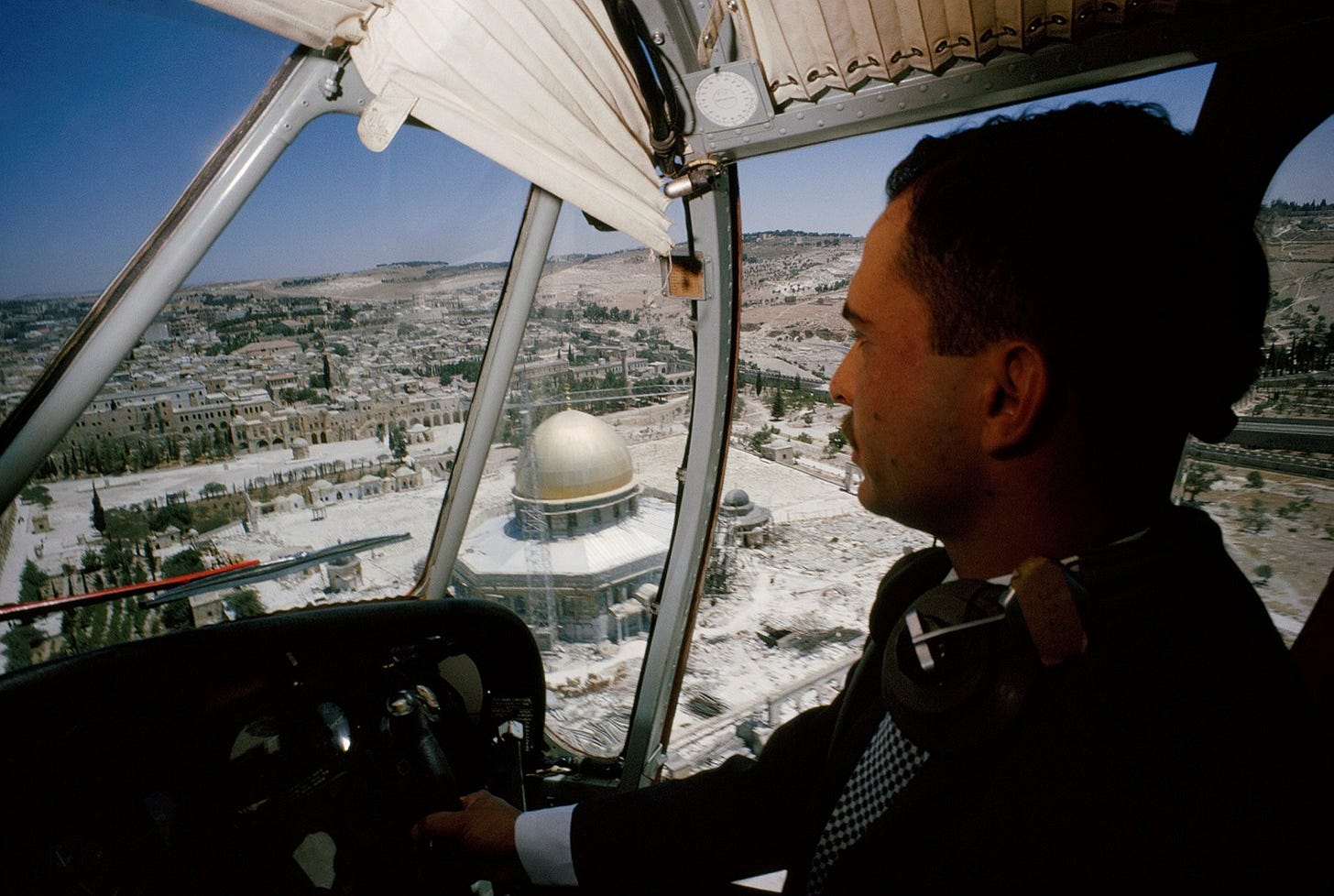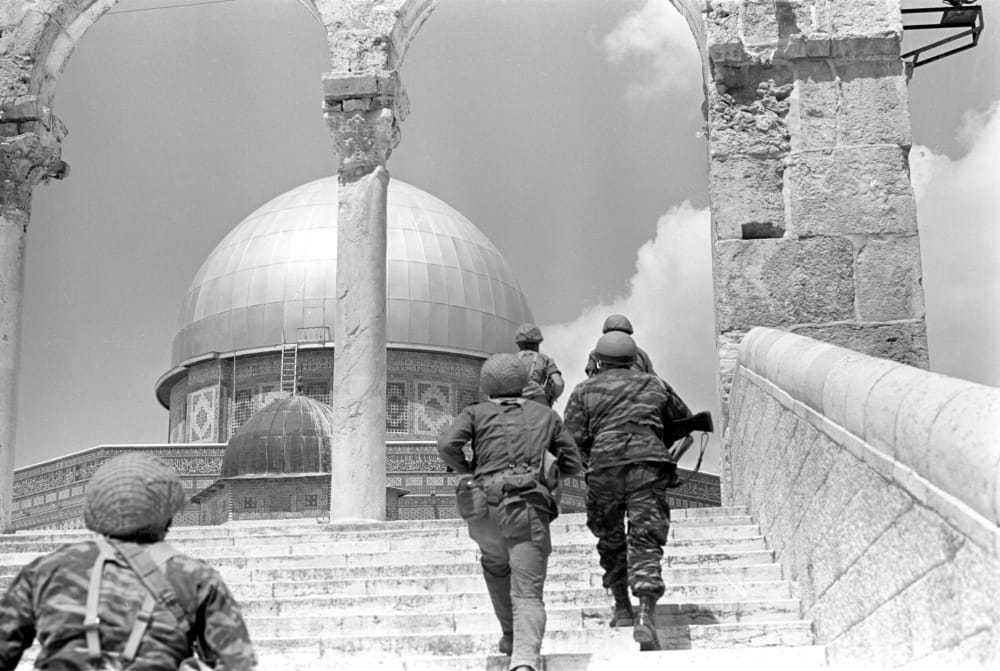The Jewish Divide Over the Temple Mount
Some Jews believe it is permissible to visit and pray at the Temple Mount in Jerusalem, while others do not. This is the backstory.

Please consider supporting our mission to help everyone better understand and become smarter about the Jewish world. A gift of any amount helps keep our platform free of advertising and accessible to all.
This is a guest essay written by Alex Stein of Love of the Land.
You can also listen to the podcast version of this essay on Apple Podcasts, YouTube Music, YouTube, and Spotify.
On Tuesday morning, Israeli National Security Minister Itamar Ben Gvir made another controversial visit along with other Israeli Jews to the Temple Mount in Jerusalem, repeating that it was his policy to allow the practice.
“There is great progress here on [matters of Israeli] sovereignty and rule, images of Jews praying here as I’ve said. Our policy is to allow prayer,” he said during their visit to mark the solemn Jewish fast day of Tisha B’Av, which mourns the destruction of the ancient First and Second Temples that once stood in Judaism’s holiest site.
This was the third time that the police minister has made such a claim while visiting the Temple Mount, with the Prime Minister’s Office being continually forced to issue denials that this is the State of Israel’s policy.
Back in June, Ben Gvir again declared that Jews are now allowed to pray at the Temple Mount, despite a decades-long ban on the practice.
“I was at the Temple Mount last week,” he said. “I prayed at the Temple Mount and we are praying at the Temple Mount. I am in the political echelon, and the political echelon allows Jewish prayer at the Temple Mount.”
Other members of the political echelon were quick to contradict him. Israeli Prime Minister Benjamin Netanyahu’s office released a statement declaring that Israel’s policy “to maintain the status quo on the Temple Mount [whereby Muslims pray at the Temple Mount/Haram al-Sharif and Jews pray at the Western Wall] has not changed and will not change.”
Israeli Interior Minister Moshe Arbel, of the ultra-Orthodox political party Shas, said: “The great blasphemy that has been committed cannot pass quietly,” a position which is widely shared among Israel’s ultra-Orthodox Jewish communities.
Before discussing why some religious Jews believe it is permitted to visit and pray at the Temple Mount while others do not, it is important to understand the status of the Temple Mount in Judaism.
The notion that the Temple Mount is holy irrespective of whether the Temple is present may be a post-Second Temple phenomenon; during the First and Second Temple periods, some scholars argue that Jews believed the Temple was holy but not Mount Moriah itself.
And the Temple compound had different degrees of holiness, as explained in a famous series of passages in the Mishnah (the first major written collection of the Jewish oral traditions):
“There are ten degrees of holiness. The Land of Israel is holier than any other land. The Temple Mount is still more holy, for no man or woman who has gonorrhoea, no menstruant and no woman after childbirth may enter therein. The Rampart [an area of ten cubits surrounding the Temple itself] is still more holy, for no gentiles and none that have contracted ritual impurity from a corpse may enter therein.”
“The Court of Women is still more holy, for a person who has immersed himself that very day [but the sun has not yet set] may not enter therein, yet none who enter would thereby become liable to a sin-offering. The Court of Israelites is still more holy, for none whose atonement is yet incomplete [i.e. who have not yet brought a sacrifice] may enter therein, and a person who does enter would thereby become liable to a sin-offering…”1
At the Israel Museum in Jerusalem, one can see archaeological proof of this distinction in the form of a warning sign in Greek that reads: “No foreigner may enter within the balustrade around the sanctuary and the enclosure. Whoever is caught, on himself shall he put blame for the death which will ensue.”
Following the destruction of the Temple by the Romans in 70 CE, the idea developed that one should not visit the Temple Mount in case one accidentally entered prohibited areas, although in reality there were brief periods in which Jews were able to visit.
And while I have no evidence to prove it, my hypothesis is that the rabbinic prohibitions surrounding the Temple Mount developed in response to non-Jewish rulers banning Jews from visiting the site.
Today, then, why do some Jews believe it is permissible to visit and pray at the Temple Mount while others do not?
In practice, there are four different groups among religious Jews. The first, represented by Israel’s Chief Rabbinate, forbids visiting the Temple Mount until the Messiah arrives.
The second, represented by the founder of Religious Zionism (Rabbi Abraham Isaac Kook), says that Jews should actively prepare for the Messiah without going up to the Temple Mount.
The third position, represented by “The Central Rabbi” yeshiva (an Orthodox Jewish seminary), advocates building the Third Temple, but only once sufficient spiritual elevation has been achieved.
And, finally, the increasingly dominant position among the Religious Zionist leadership is that visiting the Temple Mount is permitted and even encouraged, with certain restrictions.

Following Israel’s victory in the 1967 Six-Day War — when the State of Israel first gained control from Jordanian custody over the Old City of Jerusalem (including the Western Wall and the Temple Mount) — then-IDF Chief Rabbi Shlomo Goren advocated Jewish prayer on the Temple Mount, while the Chief Rabbinate published a declaration forbidding it: “Since the sanctity of the site has never ended, it is forbidden to enter the Temple Mount until the Temple is built.”
A month later, it even resolved “to hold no discussion or conversation about the building of the Temple.” Yitzhak Abuhatzeira, the rabbi of Ramle (a city in central Israel), demanded that a sign be placed at the site, warning people against entering, a practice that has continued to this day, although the sign is occasionally removed by dissenting groups. Rabbi Ovadia Yosef, the spiritual head of Israel’s popular ultra-Orthodox political party, Shas, even banned flying over the site.
For his part, Shlomo Goren had soldiers from the Engineering Corps map the site to identify areas prohibited to Jews, prayed Mincha (afternoon prayers) there on the Jewish holiday Tisha B’Av, and even established his office at the site, but was prevented from holding Yom Kippur prayers there by Israel’s then-Minister of Defense Moshe Dayan and IDF Chief of Staff Yitzhak Rabin.
At first, though, most people followed the Chief Rabbinate ruling. In 1986, a group called El Har Hashem (Hebrew for “To the Mountain of the Lord”) tried to encourage sanctioned visits, but without much success.
Mordechai Eliyahu, Israel’s Sephardic Chief Rabbi from 1983 to 1993, proposed that a synagogue be built within the permitted areas and that it be taller than the Al-Aqsa mosque compound and “Dome of the Rock” (an Islamic shrine at the center of the compound) at the Temple Mount. Going even further, in 1984 the Jewish Underground plotted to blow up the mosques and replace them with the Third Temple.
It was only in the 1990s, though, against the backdrop of the Oslo Accords peace process between Israel and the Palestinians, that the pro-visit faction gained significant support.
In 1996, the Council of Yesha Rabbis ruled that Jews were permitted to visit the Temple Mount, and should even be encouraged to do, if they stayed away from certain areas and underwent ritual purification beforehand. It urged rabbis to “ascend the Mount themselves, and to guide their congregants in ascending the Mount within all the limitations of the Halacha,” in response to “the facts that are being established on the ground by Arabs.”
Israel’s Chief Rabbinate, meanwhile, remained unmoved.

Then, in 2000, Rabbi Yisrael Ariel, the founder of the Jerusalem-based Temple Institute — which focuses on establishing the Jews’ Third Temple — published an article titled, “The Commandments of the Temple Mount at this Time.” In it, Ariel argued that the laws of conquest permitted Jews to go up to the Temple Mount, writing:
“… the commandment to conquer the land is a commandment from the Torah for every generation … liberation of the holy place — is the height of conquests in the land ahead of the building of the Temple.”
For the first time, a major rabbi had erased the principle of distinguishing between the different areas of the Temple Mount, one that had previously been accepted by both supporters and opponents of Jewish visits. Ironically, though, with the outbreak of the Second Intifada (a violent Palestinian uprising) in 2000, Israeli Jews were now prevented from visiting the Temple Mount entirely until 2003, when the number of Jewish visitors spiked noticeably; it has continued increasing ever since.
Today the Israeli government repeatedly insists that the status quo remains in place, while attempts to erode it gain in strength year by year. Those advocating for Jewish prayer at the Temple Mount portray it as a civil rights issue, no doubt in response to the framing of the Israeli-Palestinian conflict in these terms.
On the other hand, the Jerusalem Waqf (a council composed of 18 members and headed by a director, all appointed by Jordan) and other Palestinian leaders frequently deny the Jewish connection to the site in its entirety (something they did not do 100 years ago).
In the meantime, the odd site of Jews on the same side of the political spectrum arguing intensely over the issue is a reminder that the Jewish religious world is not as united as it might seem from the outside looking in.
Kelim 1:6-9


It’s called the TEMPLE Mount, not the Mosque Mount, not the Dome of the Rock Mount. It’s not the Muslims’ Temple Mount. It’s the Jews’ Temple Mount on which Muslim invaders built mosques.
In June of '67, the Israeli flag flew briefly over the Dome of the Rock, having been raised there by the soldiers who librrated Jerusalem. Too bad that Moshe Dayan worried about the negative response from the Jordanians and had it hauled down. Nothing else comes close to screaming ownership like spent bullet casings on the ground and your flag flying overhead.